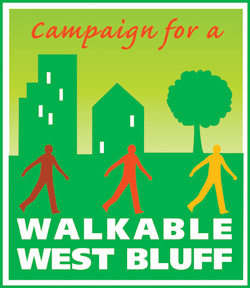Peoria’s West Bluff community is home to a nationally-rated private university with more than 5,000 students, an exciting business incubator for medical and technical innovations, a concentrated number of Peoria’s ethnic restaurants and stores, and some of the most historic homes and neighborhoods in the area. Visitors can experience theatre, music and art, all within a short walk of Main Street. Planning for the new downtown hotel and riverfront museum make the headlines, but visitors attracted by these institutions will be looking for more to do in Peoria to fill their day or weekend. One short walk or bus ride up the Main Street hill, and they could be met by a creative, exciting commercial corridor anchored by the history and beauty of the West Bluff.
Place-making proponents talk about the “Power of Ten”—the idea that a great place needs a concentrated volume of activities or “reasons to be there” to create a truly walkable environment (or a memorable weekend away from home). For example, on your way to the coffee shop, you stop to mail a letter, buy a newspaper to read in the open-air plaza, say hello to a neighbor, listen to a street musician play guitar, pick up a flyer for a knitting class at the community center, stop in to look at a local artist’s exhibit, read an historical plaque on a building, and pick up a gallon of milk on your walk home. This isn’t an unrealistic dream. Communities across the country are achieving this—and more—for quality of life for those who live in these neighborhoods, but more importantly, to promote a thriving, sustainable city as well.
Those who support the Campaign for a Walkable West Bluff are definitely concerned with quality-of-life issues, focusing on walkability for health, economic and environmental reasons. The Campaign was founded just over a year ago by a group of West Bluff neighbors who were ready to engage, energize and organize the community around the principles of New Urbanism to create a vibrant, economically strong, pedestrian-friendly Main Street. There is little “new” about New Urbanism. If anything, it is a harkening back to the old—the era of traditional town planning—where you lived, shopped, played, went to school and interacted with neighbors on a daily basis, all in your neighborhood.
 Since the mid-1950s when the interstate highway system was first introduced and Americans were seduced by the suburban “ideal”—the car, the house, the garage and the lawn—our city streets have been designed as channels for an ever-increasing number of motorized vehicles. Many of them look like highways—smooth and straight with narrow or no sidewalks, fast-moving vehicles and multiple lanes to carry as many cars as possible through our community, but not stopping to support our community.
Since the mid-1950s when the interstate highway system was first introduced and Americans were seduced by the suburban “ideal”—the car, the house, the garage and the lawn—our city streets have been designed as channels for an ever-increasing number of motorized vehicles. Many of them look like highways—smooth and straight with narrow or no sidewalks, fast-moving vehicles and multiple lanes to carry as many cars as possible through our community, but not stopping to support our community.
Everyone has a right to choose where and how they want to live, but for those of us who have chosen the older, urban-core neighborhoods of the city, our “highway-esque” commercial streets are doing a disservice to us and to the rest of the city. Peoria cannot continue to expand outward without viable, urban-core neighborhoods that serve as its foundation.
The Campaign conducted an audit in 2008 to catalogue the current retail, pedestrian and physical environment of Main Street from University to Sheridan Road. Conclusions from four different auditing teams painted a picture of deteriorating commercial buildings, vacant storefronts, an unsafe and unfriendly pedestrian environment, virtually no amenities for alternative modes of transportation, and an undersupply of essential goods and services. For anyone who has visited Main Street in the West Bluff in the last decade, these conclusions come as little surprise. Retail in urban neighborhoods has been declining nationwide for decades. Unfortunately, most potential homebuyers rate the availability of goods and services as a key factor in their buying decisions. Without retail, housing declines. Without housing, retail cannot survive. So where does one begin, and the other end?
The Campaign has outlined three broad goals that revolve around building a community vision. We see this as a neighborhood-driven campaign to reclaim our streets and create a sustainable urban environment. We have a dedicated list of supporters, several very generous business partners, and a long road ahead. Since 2002, when Duany Plater-Zyberk first unveiled the Heart of Peoria Plan, Peoria has struggled to meaningfully adopt the ideals of walkability. The City conducted Phase I of a traffic study in the West Bluff in 2008 with recommendations for changes to Main Street that might move us a little closer to our ideal. The Campaign feels strongly that any infrastructure changes to Main Street must also include neighborhood traffic-calming measures. It is our hope that Phase II of the study will move forward with continued input from the neighborhoods.
What Peoria doesn’t lack is a long list of initiatives, projects and plans, but who’s connecting the dots, promoting collaboration on projects, and advocating creation of one unified, walkable city? The Campaign is focusing on our corner in the West Bluff, but access to safe sidewalks, adequate public transportation, designated bike lanes, green space and neighborhood retail, where appropriate, are goals for the entire City to strive for.
For more information, visit www.walkablewestbluff.org. iBi


